Best Pole for Monstera Deliciosa: Support and Growth Tips!
For Monstera deliciosa, an ideal support pole is essential for maintaining structural integrity and promoting healthy growth. Sphagnum moss poles offer excellent water retention and root adherence.
Coco coir poles, derived from coconut husk, mimic the plant’s natural climbing environment. Rigid bamboo stakes provide eco-friendly, sustainable support, while metal poles crafted from stainless steel or aluminum guarantee resilience and corrosion resistance.
PVC pipes present a cost-effective, customizable height solution resistant to environmental stressors. Choosing the right height, typically 1.5 times the plant height, and understanding maintenance protocols are crucial for robust development and stability.
To explore each option’s advantages, continue for in-depth insights.
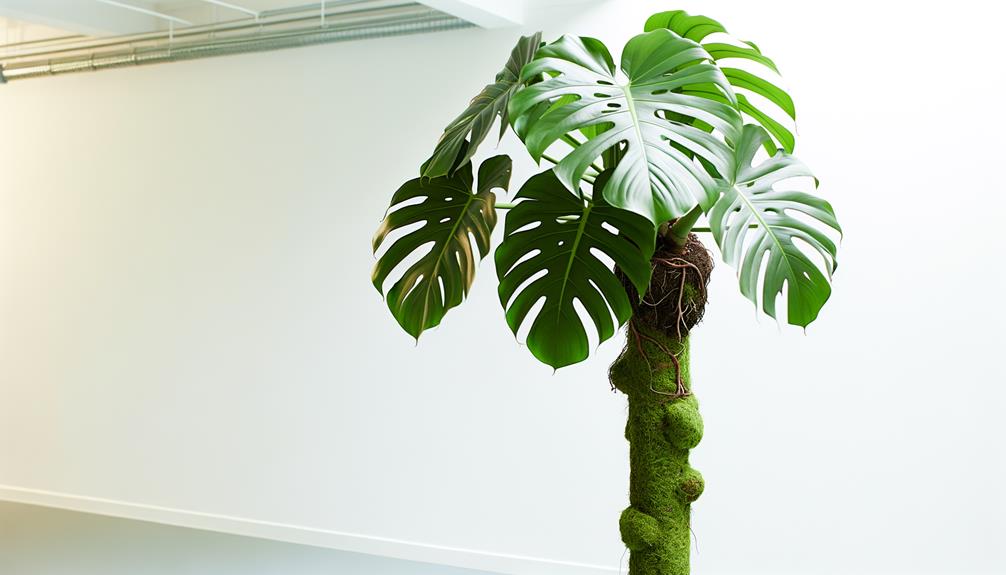
Key Takeaways
- Moss poles retain water effectively and promote root adherence, ideal for Monstera Deliciosa.
- Coco coir poles mimic natural climbing environments and enhance nutrient absorption.
- PVC pipes offer cost-effective, robust, and durable support for Monstera Deliciosa.
- Bamboo stakes provide eco-friendly, rigid support for vertical growth.
- Metal poles ensure stability and are resilient for vigorous Monstera growth.
Moss Poles
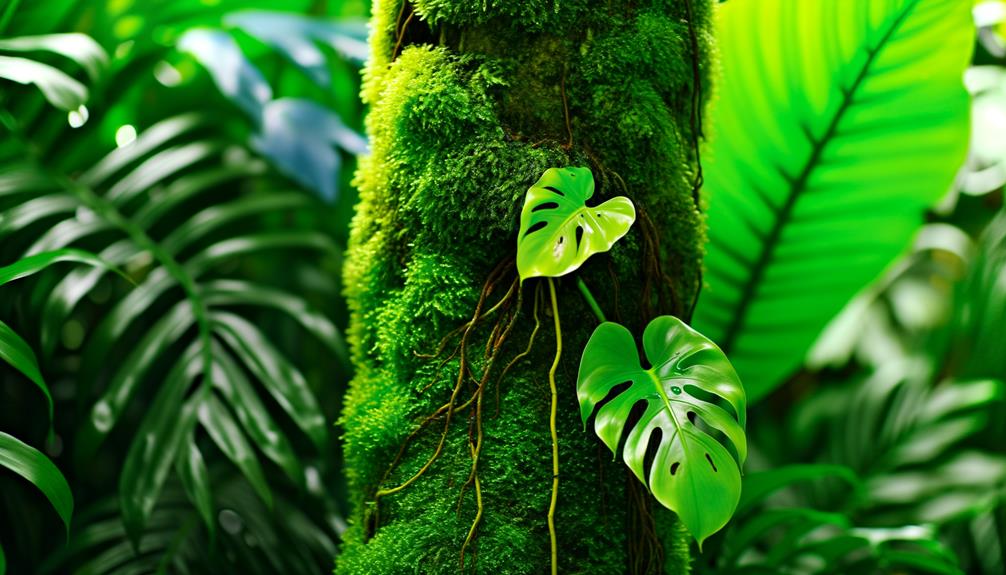
Moss poles, often made of sphagnum moss (Sphagnum spp.), provide a stable and moisture-retentive support structure that mimics the natural climbing habitat of Monstera deliciosa.
The hydrophilic properties of sphagnum moss enable it to retain water effectively, thereby maintaining an ideal humidity level for the aerial roots of Monstera deliciosa. This promotes robust root adherence and vertical growth, essential for the plant’s development.
Additionally, the porous texture of moss facilitates air circulation around the roots, preventing root rot and fostering healthy growth. The fibrous composition of sphagnum moss also offers structural integrity, making it an ideal medium for supporting the climbing tendencies of Monstera deliciosa.
This way, moss poles enhance both the aesthetic and physiological well-being of the plant.
Coco Coir Poles
Using coco coir poles, derived from the fibrous husk of Cocos nucifera, offers an alternative support structure that promotes the vertical growth and health of Monstera deliciosa. The fibrous texture of coco coir mimics the plant’s natural climbing environment, facilitating the attachment of aerial roots.
This natural material retains moisture effectively, thereby maintaining a humid microclimate conducive to Monstera deliciosa’s growth. Additionally, coco coir’s high lignin content ensures durability and resistance to microbial degradation.
In horticultural practice, the use of coco coir poles enhances nutrient absorption and encourages robust foliar development.
However, it is vital to secure the pole’s stability and attach it securely to the plant to prevent structural stress and potential damage to the Monstera deliciosa.
Bamboo Stakes

In contrast to coco coir poles, bamboo stakes (Bambusa spp.) present a rigid and sustainable support option for Monstera deliciosa, offering structural integrity and ease of installation. Their tensile strength and natural resistance to environmental degradation make them particularly suitable for indoor and outdoor use.
Bamboo’s high lignin and cellulose content contribute to its robustness, enabling it to support the weight and growth of the Monstera deliciosa effectively. Additionally, bamboo stakes are eco-friendly, as bamboo is a rapidly renewable resource.
Installation involves inserting the stakes firmly into the substrate and securing the plant with ties, ensuring minimal disturbance to root systems. This method promotes vertical growth and air circulation, which can mitigate fungal infections and enhance overall plant health.
Trellis Supports
Trellis supports for Monstera deliciosa (Monstera deliciosa Liebm.) offer various structural configurations, including flat, arched, and lattice designs, each providing unique advantages for aerial root attachment and vertical growth.
Proper installation involves securing the trellis firmly to the pot or ground to guarantee stability as the plant matures.
Material selection, ranging from metal to plastic and wood, notably impacts durability, aesthetics, and potential interactions with the plant’s physiology.
Types of Trellis
Several trellis support options, including moss poles, coco coir poles, and metal grid trellises, can provide structural stability and ideal growth conditions for *Monstera deliciosa*.
Moss poles, typically composed of sphagnum moss, offer a moisture-retentive surface conducive to aerial root attachment and nutrient absorption.
Coco coir poles, derived from fibrous coconut husks, similarly support root adhesion while maintaining a balanced moisture environment.
Metal grid trellises, composed of galvanized steel or similar materials, afford robust support and can be configured to accommodate vertical or horizontal growth patterns.
Each type of trellis offers distinct advantages: moss poles and coco coir poles enhance hydration and nutrient uptake, whereas metal grid trellises deliver unparalleled structural integrity, essential for mature *Monstera deliciosa* specimens.
Installation Tips
When installing trellis supports for *Monstera deliciosa*, it is important to make sure that the support structure is securely anchored in the potting medium to provide stability and promote most favorable growth.
Ensuring strong anchorage can be achieved by embedding the trellis base at least 6-8 inches deep into the substrate, preferably in a potting mix with a high organic matter content for best root interaction.
Additionally, consider the alignment of the trellis relative to the plant’s main stem (petiole) to facilitate natural climbing behavior via its adventitious roots. Properly tying the stem to the trellis with soft, flexible ties can prevent mechanical damage while encouraging vertical growth.
Regular monitoring and adjustments are essential to accommodate the plant’s dynamic growth patterns.
Material Choices
Selecting the best material for trellis supports in *Monstera deliciosa* cultivation is pivotal for ensuring structural integrity and promoting healthy growth dynamics. The choice of material directly impacts the plant’s ability to climb, air root attachment, and stability.
Common materials include moss poles, coco coir poles, and bamboo stakes. Moss poles, composed of sphagnum moss, provide an ideal moist environment that mimics the plant’s natural habitat. Coco coir poles offer a sustainable and durable option, while bamboo stakes are lightweight and eco-friendly.
| Material | Benefits | Drawbacks |
|---|---|---|
| Moss Pole | Excellent moisture retention, natural habitat | Requires frequent watering |
| Coco Coir | Durable, sustainable | May dry out quickly |
| Bamboo Stake | Lightweight, eco-friendly | Less moisture retention |
Each material choice should be evaluated based on the specific needs and environment of your Monstera deliciosa.
Metal Poles

Metal poles, typically crafted from stainless steel or aluminum, offer a resilient and corrosion-resistant support option for Monstera deliciosa. These materials are advantageous due to their high tensile strength and longevity, making them ideal for bolstering the vigorous growth of Monstera deliciosa, also known as the Swiss cheese plant.
The following benefits underscore their suitability:
- Durability: Stainless steel and aluminum resist rust and corrosion, guaranteeing long-term stability.
- Strength: These metals provide exceptional structural support, accommodating the substantial weight of mature plants.
- Aesthetic Appeal: Metal poles offer a sleek, contemporary look that complements modern indoor environments.
- Easy Maintenance: Metal surfaces are easy to clean and disinfect, reducing the risk of pest infestations.
Using metal poles ensures that Monstera deliciosa receives the best structural support throughout its growth cycle.
Wooden Poles
Wooden poles, often crafted from materials such as bamboo or cedar, provide a natural and aesthetically pleasing support for Monstera deliciosa, facilitating the plant’s epiphytic growth habits.
These poles emulate the tree trunks that Monstera deliciosa (syn. Monstera pertusum) would naturally climb in their native tropical habitats. Bamboo poles are particularly advantageous due to their lightweight nature and resistance to rot, while cedar’s natural oils offer inherent pest resistance.
The rough texture of these woods aids in root adhesion, promoting robust aerial root development. Additionally, wooden poles contribute to the microenvironment by retaining moisture, essential for the plant’s hydration.
PVC Pipe Supports
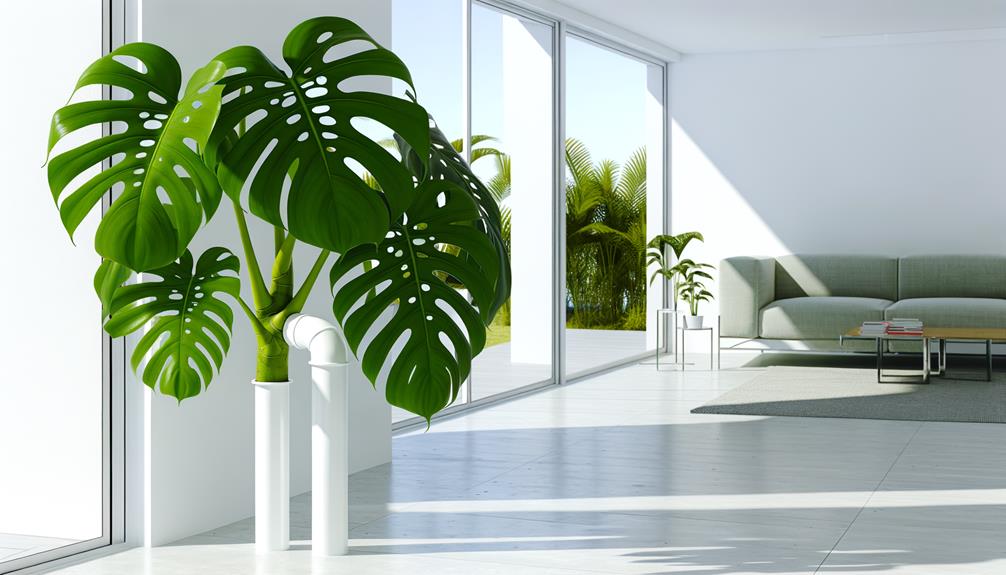
PVC pipe supports present a structurally robust and economically viable alternative for training Monstera deliciosa. These supports offer superior durability and stability, withstanding environmental stresses while maintaining best vertical support.
Additionally, the customizable height options of PVC pipes enable tailored solutions to accommodate the growth patterns and morphological characteristics of Monstera deliciosa.
Durability and Stability
Given its resilience and rigidity, polyvinyl chloride (PVC) pipe offers a highly effective support structure for Monstera deliciosa, ensuring both durability and stability for the climbing plant.
The structural integrity of PVC pipe is particularly advantageous for Monstera deliciosa, scientifically known as Monstera deliciosa Liebm., due to its robust and extensive growth pattern.
Critical factors contributing to PVC’s effectiveness include:
- Longevity: Resistant to environmental stressors, ensuring prolonged support.
- Load-Bearing Capacity: Capable of sustaining the plant’s weight without deformation.
- Chemical Resistance: Unaffected by fertilizers and other chemicals commonly used in horticulture.
- Dimensional Stability: Maintains shape and form under varying temperature conditions.
These attributes collectively make PVC pipes an ideal choice for providing steadfast support, thereby promoting healthy vertical growth in Monstera deliciosa.
Cost-Effective Solution
An economical alternative for supporting Monstera deliciosa, the use of polyvinyl chloride (PVC) pipe provides a cost-effective solution without compromising on structural integrity.
PVC pipes, composed of durable thermoplastic polymer, offer exceptional strength-to-weight ratio, guaranteeing robust support for the climbing epiphyte, Monstera deliciosa.
With a high resistance to moisture, UV radiation, and microbial degradation, PVC pipes are ideally suited for both indoor and outdoor environments.
The inert nature of PVC minimizes chemical interactions with soil and plant tissues, preventing potential adverse effects on root development and foliage health.
Additionally, PVC’s ease of modification and availability in various diameters facilitate tailored support structures, accommodating the unique growth patterns of Monstera deliciosa.
This ensures sustained vertical growth and best aerial root anchorage.
Customizable Height Options
A notable advantage of polyvinyl chloride (PVC) pipe supports is their customizable height options, which can be precisely adjusted to meet the vertical growth requirements of Monstera deliciosa. This flexibility is essential for the best development of this species.
Customizable height options offer several benefits:
- Incremental Adjustments: PVC pipes can be cut to specific lengths, allowing for gradual height adjustments as Monstera deliciosa matures.
- Stability: The inherent rigidity of PVC provides strong support, important for the heavy aerial roots and large leaves of Monstera deliciosa.
- Durability: PVC is resistant to moisture and decay, ensuring longevity in various indoor environments.
- Ease of Assembly: Modular design facilitates simple construction and modification, accommodating the plant’s ongoing growth cycle.
These features collectively optimize the structural support for Monstera deliciosa.
Custom DIY Poles
Crafting custom DIY poles for Monstera deliciosa involves understanding the specific growth habits and structural needs of this epiphytic species to guarantee support and health. Monstera deliciosa, known for its aerial roots and climbing tendencies, requires sturdy, moisture-retentive poles to simulate its natural environment.
Essential materials such as sphagnum moss, PVC pipes, and coconut coir are integral to constructing efficient support systems. Each material affects the plant’s grip and moisture retention capabilities, fostering ideal growth.
| Material | Benefits | Drawbacks |
|---|---|---|
| Sphagnum Moss | High moisture retention | May decompose over time |
| PVC Pipes | Durable and customizable | Lacks natural aesthetic |
| Coconut Coir | Eco-friendly and good root grip | May dry out quickly |
Understanding these elements helps in creating a support system that complements Monstera deliciosa’s natural growth patterns.
Choosing the Right Height
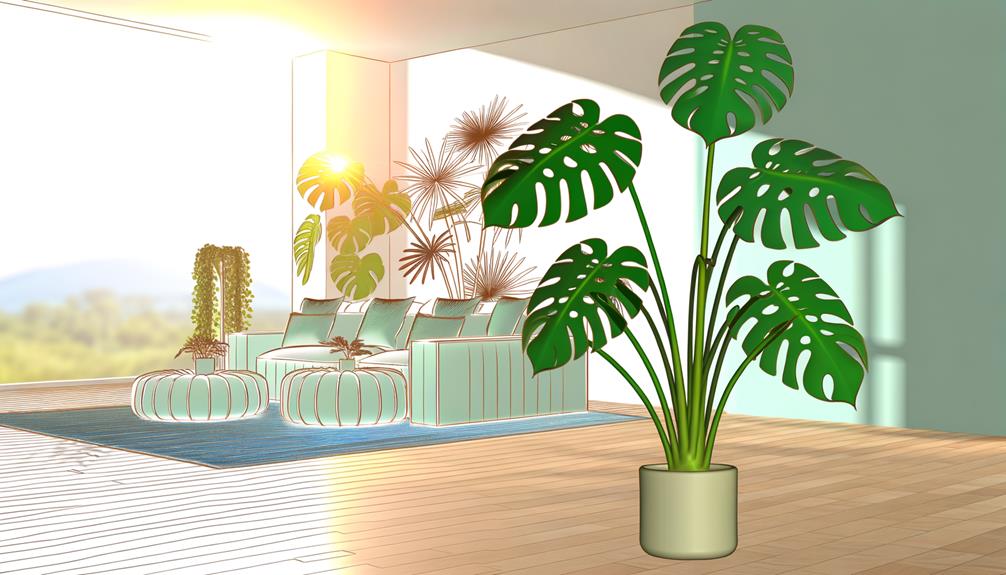
Determining the appropriate height for support poles is essential to accommodate the vertical growth and climbing nature of Monstera deliciosa (syn. Monstera deliciosa Liebm.), ensuring robust development and stability.
The height of the pole should account for the following factors:
- Initial Plant Height: The pole should be at least 1.5 times the height of the Monstera at the time of installation.
- Growth Rate: Monstera deliciosa can grow several feet annually; a taller pole may be necessary to accommodate future growth.
- Structural Support: The pole must be sturdy enough to support the weight of mature leaves and stems.
- Aesthetic Considerations: The pole should blend with the plant’s natural growth habit, enhancing its aesthetic appeal without overwhelming the visual balance.
Installation Tips
Proper installation of the support pole for Monstera deliciosa involves several key steps to guarantee stability and promote healthy growth of the plant.
Initiate by selecting a pole material such as moss-covered or coir-wrapped poles, which offer aerial root attachment points. Insert the pole centrally in the pot, making sure it is buried at least 10-15 cm deep to provide a secure anchor.
Position the Monstera deliciosa (Monstera deliciosa Liebm.) adjacent to the pole, gently guiding its stems and aerial roots towards the support. Secure the stems using plant ties or soft twine, avoiding constriction to prevent damage.
Consistent monitoring during initial growth phases assures the plant adapts effectively to the support structure, promoting vertical growth and structural integrity.
Maintenance and Care
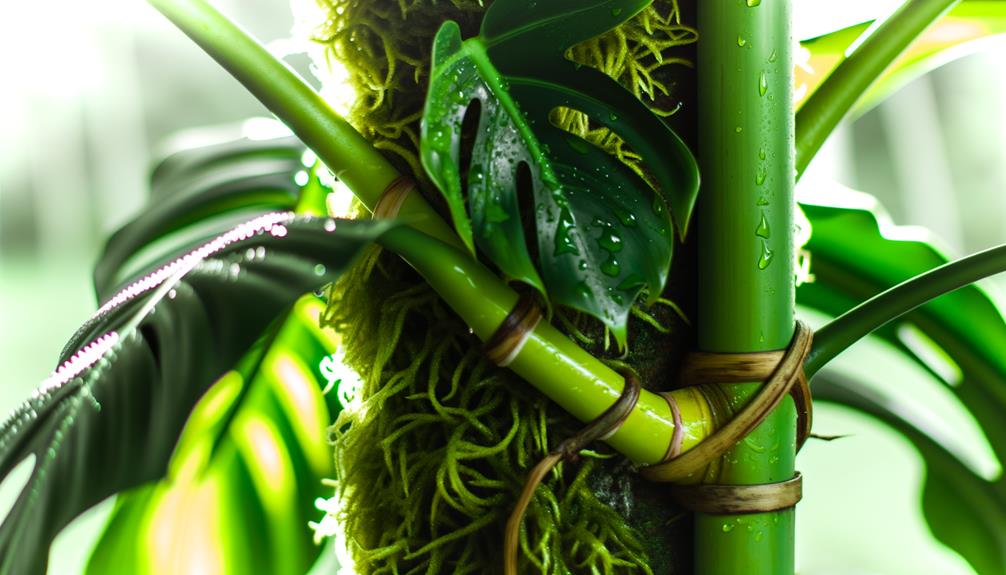
Maintaining the continued health and stability of Monstera deliciosa (Monstera deliciosa Liebm.) requires regular upkeep of the support pole, including periodic checks for structural integrity and adjustments to plant ties as the plant grows. Effective maintenance practices guarantee the pole remains a reliable support structure, fostering prime plant growth.
Key steps involve:
- Structural Inspection: Evaluate the pole for any signs of wear or weakness, ensuring it remains sturdy.
- Plant Tie Adjustments: Regularly modify ties to accommodate new growth, preventing constriction and potential damage.
- Sanitization: Clean the pole to remove any pathogens or pests, maintaining a healthy environment for the plant.
- Nutrient Monitoring: Guarantee the growing medium around the pole is adequately enriched with essential nutrients to support robust growth.
These measures collectively enhance the longevity and strength of Monstera deliciosa.
Conclusion
To sum up, choosing the best support framework for Monstera deliciosa entails a thorough examination of different choices. These include moss poles, coco coir poles, bamboo stakes, trellis supports, metal poles, and custom DIY poles. Each kind of pole provides unique benefits based on the plant’s growth needs and surrounding conditions.
The correct height, correct installation, and consistent upkeep are vital for the plant’s structural strength and overall well-being. Similar to a perfectly fitted outfit, the suitable support will guarantee Monstera deliciosa flourishes magnificently.






